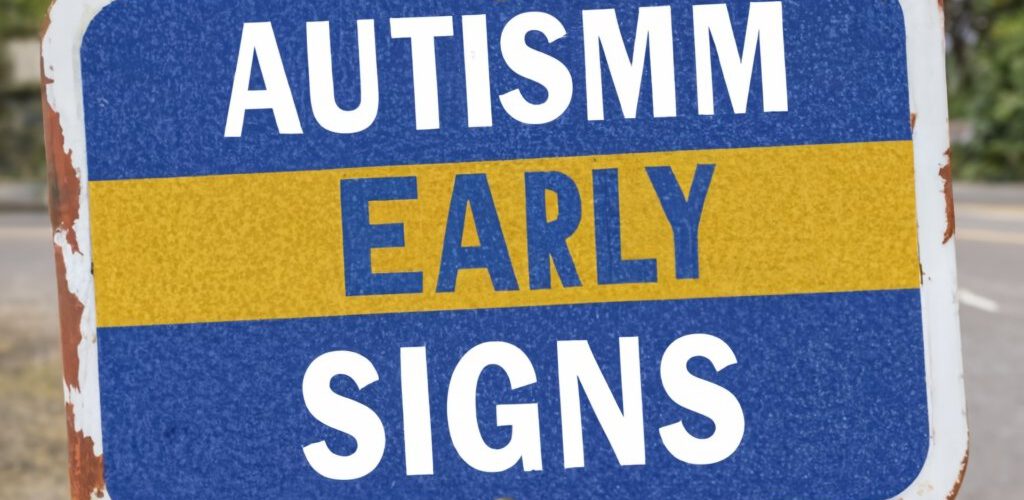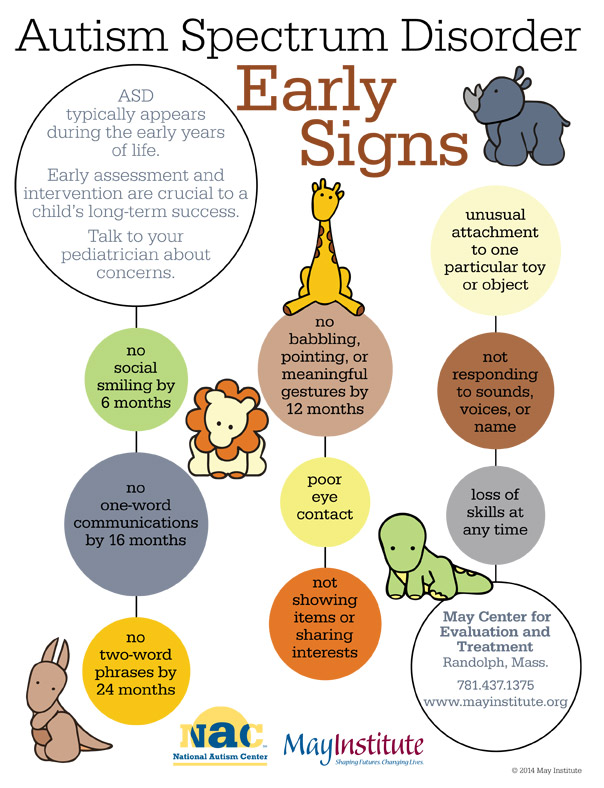
Autism spectrum disorder (ASD) includes a range of conditions. These conditions are characterized by challenges with social skills, repetitive behaviors, speech, and nonverbal communication. Autism affects an estimated 1 in 44 children in the United States. Early identification and intervention are key to helping children with autism reach their full potential. This article will explore the early signs and symptoms that may indicate a child is on the autism spectrum.
What is Autism Spectrum Disorder?
Autism, or autism spectrum disorder, encompasses a broad range of neurodevelopmental disorders. The term “spectrum” reflects the wide variation in challenges and strengths of each autistic person. There are three main areas where people with ASD often have difficulties:
- Social communication and interaction – This includes challenges with social-emotional reciprocity, nonverbal communicative behaviors, and developing and maintaining relationships.
- Restricted, repetitive patterns of behavior involve repetitive motor movements. There is an insistence on sameness. The interests are highly restricted or there is hyper-reactivity to sensory input.
- Symptoms that hurt the person’s ability to function properly in school, work and other areas of life.
The symptoms of autism vary widely from person to person, ranging from mild to severe. That’s why autism is considered a “spectrum” disorder. Some people with ASD can live independently, while others require life-long care and support.
When Does Autism Typically Appear?
The hallmark signs of autism usually appear between 12 and 24 months of age. According to the CDC, over half of children with autism show hints of developmental differences by their first birthday. By age 2, most autistic children show some behavioral signs and symptoms. However, some children seem to develop normally until the second year of life. Then, they gradually or suddenly exhibit ASD symptoms.
While autism is typically identified in early childhood, some individuals are not diagnosed until much later. A late diagnosis does not mean the person suddenly developed autism. Instead, symptoms that might not have been recognized during childhood become clearer during adolescence. These symptoms also become more noticeable with adulthood’s social and communication demands.
Early Signs of Autism
No two children with autism are exactly alike. However, several common early signs may point to autism spectrum disorder. It is important to remember that many of these symptoms occur in all children at some point in their development. Autism is marked by a pattern of persistent deficits rather than isolated behaviors. Parents should consider raising any concerns about the following signs with a pediatrician:
Social Development
- Lack of smiling or other joyful expressions by 6 months
- Limited or absent imitation (e.g., clapping hands, waving goodbye) by 12 months
- Lack of warm, joyful expressions primarily directed at people by 12 months
- Reduced sharing of interests or enjoyment by 14 months
- Lack of response to their name being called by 12 months
- Little or no eye contact
- preference to play alone rather than with other children
- Difficulty understanding or expressing emotions
Communication Development
- Limited or lack of babbling by 12 months
- Not using simple gestures like pointing or waving by 12 months
- No spoken words by 16 months
- Loss of language or social skills previously acquired
- Odd or repetitive vocalizations or speech patterns (echolalia)
- Referring to self as “you” or “she/he” beyond 24 months
- Difficulty starting or sustaining conversations
- Repeating words or phrases over and over (echolalia)
Behavioral Patterns
- Excessive lining up or arranging of toys or objects
- Intense reactions to sounds, smells, tastes, textures or appearances of things
- Rigid adherence to routines and extreme resistance to change
- Restricted interest in a few activities or topics
- Unusual repetitive behaviors like hand flapping, spinning, or rocking
- Unusual posture, gaze, or walk
- Distress over minor changes in environment or daily routine
- Less imaginative or imitative play than peers
Delays in Other Areas
- Late talking (first words after 16 months)
- Slow to develop motor skills like sitting up, crawling, or walking
- Unusual sensory interests or aversions
- Under- or over-responsiveness to pain or other stimuli
- Lack of eye contact
- Lack of interest in other children or caregivers
- Poor eye contact or lack of response when the name is called
The appearance of any of these red flags does not necessarily mean a child has autism spectrum disorder. However, if your child exhibits multiple signs of possible autism, share your concerns with your pediatrician immediately. Early screening and intervention are vital to supporting the best possible outcome for children with autism.
Importance of Early Detection
Detecting autism spectrum disorder in infants and toddlers is critical. The earlier autism is identified and treated, the better the outcome for the child. Children who receive targeted interventions before age 3 have significantly improved cognitive skills. Their language ability is enhanced. They also show better social functioning later in life. Early intensive therapy can potentially help some children catch up developmentally before kindergarten.
Here are some key reasons why early detection is so valuable:
- It allows time to access beneficial early intervention services while the child’s brain rapidly develops. Neural connections are most flexible for learning new skills early in life.
- Earlier enrollment in special education often results in higher IQs and improved language and social skills.
- Starting autism therapies like applied behavior analysis before age 4 can significantly improve symptoms for some children with ASD.
- Families are empowered to understand ASD and make informed choices for treatment and services.
- Siblings and other family members can receive counseling and support.
- Diagnosis helps families connect with ASD resources, specialized providers, and support groups.
The CDC recommends all children be screened for autism spectrum disorder by a trained physician during regular well-child visits at 9, 18, and 24 or 30 months. Additional ASD screening may use tools like the Modified Checklist for Autism in Toddlers (M-CHAT) or the Screening Tool for Autism in Toddlers and Young Children (STAT). If any screening indicates a risk for ASD, the child should be referred for immediate confirmatory diagnostic testing.
In some milder or late-onset cases, autism may not be recognized until a child is in preschool or elementary school. Seeking an ASD evaluation whenever concerns arise ensures children get timely support to reach their full potential. Contact a pediatrician, school counselor, or developmental psychologist for assistance with assessment.
Autism Diagnosis and Treatment
If screening results indicate a high risk for autism spectrum disorder, the child will be referred for a comprehensive diagnostic evaluation. A team of specialists, including a developmental pediatrician, speech-language pathologist, occupational therapist, and clinical psychologist, will conduct formal autism assessment activities. Standard diagnostic tests include:
- Developmental screening – Assesses cognitive, motor, language, behavioral, and social skills using validated instruments like the Mullen Scales of Early Development.
- Autism diagnostic tools – Structured tests designed to identify and evaluate autism symptoms based on parent interviews and clinician observation of the child. These include the Autism Diagnostic Observation Schedule (ADOS-2) and the Autism Diagnostic Interview-Revised (ADI-R).
- Hearing and vision exams – To identify any sensory deficits impacting development.
- Testing for other conditions – Checks for genetic disorders like Fragile X syndrome and tuberous sclerosis that may have overlapping symptoms with ASD.
After a thorough assessment, the diagnosis of autism spectrum disorder will be made based on criteria in the Diagnostic and Statistical Manual of Mental Disorders (DSM-5). The clinical team provides a detailed assessment report to help guide treatment planning.
Early intervention is the best way to help children with autism spectrum disorder. Recommended therapies include:
- Behavioral therapies – Applied behavior analysis uses positive reinforcement to improve communication, social skills, and behavior. Modeling, self-management, and cognitive behavioral approaches are also beneficial.
- Speech therapy – A speech-language pathologist helps the child improve verbal and nonverbal communication skills. Alternative communication tools like picture symbols may be introduced.
- Occupational therapy – focuses on adaptive life skills like dressing, eating, and using tools. Also addresses sensory integration issues.
- Physical therapy – Develops gross motor coordination and balance.
- Medications – This may be used to manage high energy levels, inability to focus, depression, seizures, or other medical issues associated with ASD.
- Educational plan – Federal law mandates that public schools provide specialized support and services in the least restrictive environment.
- Parent education – Provides families with guidance on managing behavioral challenges, effective communication strategies, and accessing support resources.
The involvement of health professionals, parents, and special educators is imperative to help the child continually build communication, social, and functional life skills. With individualized supportive therapies starting early in life, many children with ASD can learn, develop, and thrive.
Frequently Asked Questions
What are the first signs of autism in babies?
Some early red flags for autism in infants include:
- Not babbling, pointing, or using other gestures by 12 months
- No single word spoken by 16 months
- Poor eye contact
- Lack of interest in other people
- Increased sensitivity to sensory stimuli
- Reduced facial expressions and sharing of emotions
What is the best age for early detection of autism?
According to research, autism can be reliably diagnosed as early as 18 to 24 months. Early screening between 9 months and 3 years is recommended to identify ASD symptoms and begin early intervention therapies during prime developmental windows.
Can mild autism go away?
Autism spectrum disorder is a lifelong neurological condition. However, early intensive behavioral and educational therapies can help children with milder ASD develop skills and often “lose” the observable symptoms as they grow. The earlier and more intensely it is treated, the better the long-term prognosis.
What professionals diagnose autism?
Autism spectrum disorder is diagnosed by a team of trained specialists, including a developmental pediatrician, child psychologist, speech-language pathologist and occupational therapist. They conduct formal diagnostic assessments, profile the child’s skills and challenges, and make a multidisciplinary determination of ASD based on DSM criteria.
Who should screen for autism?
All children should receive autism screening during regular pediatric well-child visits at 9, 18, and 24 or 30 months per CDC guidelines. General screening tools like the M-CHAT questionnaire or STAT may be used. For children at risk for ASD, additional screening and immediate diagnostic testing is recommended.
What is the best treatment for autism?
There is no single best treatment since every child with ASD has unique strengths and challenges. However, research indicates that applied behavior analysis (ABA) at an early age provides significant benefits for developing communication and life skills. Standard evidence-based therapies include ABA, speech therapy, occupational therapy, medications, specialized education plans, and parent education.
References
American Psychiatric Association. (2013). Neurodevelopmental Disorders. In Diagnostic and Statistical Manual of Mental Disorders (5th ed.). https://doi.org/10.1176/appi.books.9780890425596.dsm01
Centers for Disease Control and Prevention. (2020, September 25). Signs and Symptoms of Autism Spectrum Disorders. https://www.cdc.gov/ncbddd/autism/signs.html
Lord, C., Risi, S., DiLavore, P. S., Shulman, C., Thurm, A., & Pickles, A. (2006). Autism from 2 to 9 years of age. Archives of General Psychiatry, 63(6), 694-701. https://doi.org/10.1001/archpsyc.63.6.694
Zwaigenbaum, L., Bauman, M. L., Choueiri, R., Kasari, C., Carter, A., Granpeesheh, D., … & Natowicz, M. R. (2015). Early intervention for children with autism spectrum disorder under 3 years of age: recommendations for practice and research. Pediatrics, 136(Supplement 1), S60-S81. https://doi.org/10.1542/peds.2014-3667E
Rogers, S. J., Vismara, L., Wagner, A. L., McCormick, C., Young, G., & Ozonoff, S. (2014). Autism treatment in the first year of life: a pilot study of infant start, a parent-implemented intervention for symptomatic infants. Journal of autism and developmental disorders, 44(12), 2981-2995. https://doi.org/10.1007/s10803-014-2202-y
Bradshaw, J., Steiner, A. M., Gengoux, G., & Koegel, L. K. (2015). Feasibility and effectiveness of very early intervention for infants at-risk for autism spectrum disorder: A systematic review. Journal of autism and developmental disorders, 45(3), 778-794. https://doi.org/10.1007/s10803-014-2235-2
